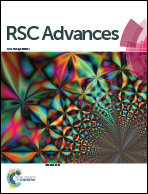Novel polyester diol obtained from PET waste and its application in the synthesis of polyurethane and carbon nanotube-based composites: swelling behavior and characteristic properties
Abstract
Waste recycling is considered a major concern for industry due to the environmental regulations imposed on industry to protect the environment. In this regard, chemical methods are not only helpful in the decomposition of wastes but also in upgrading them into worthwhile commercial materials. In this investigation, soft-drink bottles composed of polyethylene terephthalate (PET) were depolymerized via glycolysis using 2-methyl-1,3-propanediol (MPD) to obtain oligomeric dioles (diol). Nevertheless, there has been no report on the use of MPD in PET degradation. Diol can be reacted with adipic acid to lengthen the chains to obtain a polyester diol. This polyester diol has the potential for further reactions to produce various products. Here, the diol and polyester diol were characterized using FT-IR, 1H-NMR spectroscopy, and viscosity-Brookfield tests. Moreover, the molecular weight and concentration of the hydroxyl groups were determined. In the second step, novel value-added polyurethanes (cross-linked and non-cross-linked) and carbon nanotube-based polyurethane composites with different molar ratios of diisocyanate to diol (NCO/OH) were prepared using hexamethylene diisocyanate (HDI), polyester diol, and carbon nanotubes. Fourier transform infrared spectra, the thermal transitions, and degradation of the synthesized polyurethanes and nanocomposites were investigated. The swelling characteristics of the cross-linked polyurethanes were fully studied in a wide variety of non-polar to polar solvents. The diffusion profile in different solvents and the absorption kinetics were evaluated as well. The transportation of the solvents showed a Fickian sorption mechanism, while the absorption kinetics followed a pseudo-second-order model. The influence of the NCO/OH molar ratio on the swelling behavior was also investigated. The polyurethane samples, obtained from PET waste, could be used in various applications, such as industrial parts, membranes and O-rings.


 Please wait while we load your content...
Please wait while we load your content...